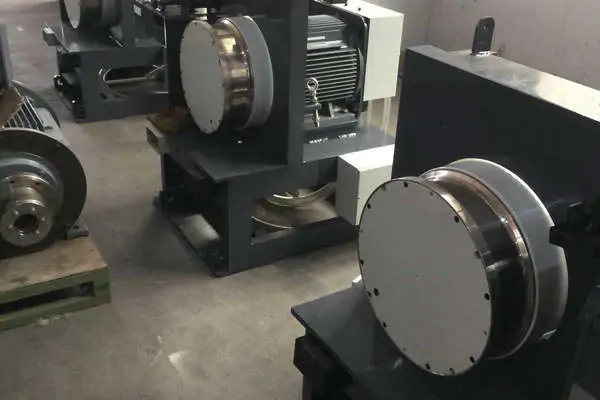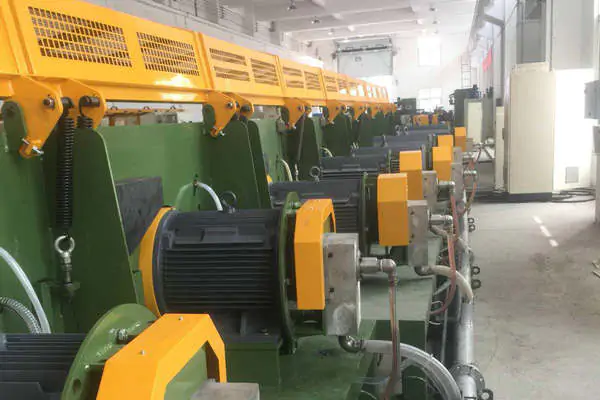
In cable and wire drawing plants, you face one basic drive decision: keep an induction motor plus gearbox, or move to a direct-drive permanent magnet synchronous motor (PMSM). That decision shows up in your energy bill, downtime, footprint, and even noise on the shop floor. Permanent magnet drive systems are already built for real production work in heavy, slow, high-torque applications such as wire drawing, conveyors, and other continuous lines.
This is not about small servos. It’s about slow speed with stable torque and clean tension control. A multi-pole PMSM can deliver high output torque at single-digit rpm without needing a reducer. For anyone comparing direct drive vs gearbox and trying to choose the best motor for wire drawing machine duty, that point matters.
A direct-drive PMSM is a permanent magnet synchronous motor coupled straight to the load instead of through a gearbox. The motor is built to run at the process speed, not at high rpm.
A PMSM rotor carries permanent magnets, so the field is always present. You don’t waste energy inducing rotor current the way an induction motor does. The stator’s rotating field and the rotor stay in sync, which lets the motor hold torque and efficiency across a wide load band. High starting torque is available for heavy starts under coil mass or tension, which is normal in wire drawing.
By choosing many poles in the rotor, the designer lowers base speed and raises torque. Rated speed can sit in the single-digit rpm range, so you get a low-speed high-torque PMSM for cable industry service without adding a reducer.
Most traditional lines run a fast induction motor plus a reducer. The motor spins fast, the gearbox drops the speed, and the drum or capstan sees usable torque.
The stack usually looks like: asynchronous motor, coupling, gearbox, and then the driven drum. It’s familiar and easy to source, but long, noisy, and alignment-sensitive. Gear mesh and slip both waste energy. Heat and vibration are part of the deal.
Gear wear, bearing wear, oil leaks, seal checks, alignment checks — this is standard work on a gearbox line. The reducer also sends vibration into the frame, raising noise and sometimes leaving marks on product. That means planned weekend stops, not optional.
You do not replace a drive layout for fun. You do it to cut cost per ton and keep output stable.
PMSM systems avoid rotor induction losses and keep very high efficiency, often in the 93 to 97 percent range, with power factor near 0.99. This holds across roughly 20 to 120 percent of rated load. An induction motor plus gearbox loses power in rotor slip, inrush, and gear mesh. That wasted input power turns into kWh on your bill.
Direct drive removes the reducer, which is the part most likely to need rebuild. With fewer couplings and fewer bearings, you cut the main source of oil leaks and vibration. Plants report quieter running and less routine maintenance. A gearbox line stays familiar but high touch, and you keep paying for lubrication and rebuild cycles.
Most of the whine next to a stand comes from the gearbox. Take the reducer out and vibration drops, so the operator’s station runs quieter. That can matter more than people admit, especially on night shift or in older buildings.
Direct drive is compact because you’re not lining up motor, coupling, and gearbox housing. You free floor space, and access to the stand improves. This matters in retrofit jobs where aisle room is already tight.
Because the PMSM rotor stays locked in step with the stator field, speed and torque control are very precise at slow speed. That helps with tension control, surface finish, and repeatable draw quality.
If you’re chasing the best motor for wire drawing machine work, this level of low-speed control is usually the deciding factor.
A gearbox drive can still be the quick answer if you just need to keep an old frame alive this quarter with minimal rework. Sometimes the legacy stand geometry makes a drop-in PMSM harder without machining a baseplate. Sometimes the local team only wants to keep the same starter cabinet. In that case, the choice is not about performance. It’s about short-term survival.
Energy cost and downtime cost drive the business case. You can get a first-pass answer fast.
Collect: yearly run hours, average load, local power price, reducer maintenance spend, and efficiency data for your current drive versus a direct-drive PMSM. PMSM numbers often show mid-90s percent efficiency and near-unity power factor even off nominal load.
Figure yearly kWh savings and subtract typical reducer service spend. Divide upgrade cost by that yearly savings to get payback time. If that payback window is shorter than the gearbox overhaul you were already planning, it’s usually an easy approval. At that point, many plants start looking at a direct drive vs gearbox retrofit based on a real low-speed high-torque PMSM for cable industry work, built for single-digit rpm and stable torque without a reducer. You can review a typical setup here as a direct drive vs gearbox upgrade choice for a cable line.

Before you change hardware, check fit and controls so start-up is smooth.
Confirm shaft size, flange pattern, base height, and how the motor will carry load once the reducer is gone. The motor now sits where the gearbox sat, so mounting matters.
This class of PMSM runs with its matched drive cabinet. That cabinet controls ramp, torque limit, and low-speed stability. You want someone to tune the loop for drawing tension, not leave generic defaults. PMSM platforms respond fast, which is great for surface quality when tuned.
A simple approach is to convert one stand first. Keep the old gearbox stand next to it as baseline. That gives you live production data instead of theory.
Qingdao Enneng Motor Co., Ltd. supplies permanent magnet synchronous motors for heavy industrial use. The range includes direct-drive and gearless solutions for jobs such as wire drawing machines, belt conveyors, oilfield PCP systems, tire equipment, and sewage aeration. These motors deliver high torque at very low speed by using multi-pole rotors, so rated speed can drop to single-digit rpm with no reducer. Typical efficiency is in the mid-90s percent and power factor is close to 1.0, even when the load is not steady. Fewer mechanical parts also means lower routine service cost, because you’re not rebuilding a gearbox. The company supports drive cabinets and integration so you can phase in direct-coupled torque without losing process stability.
If you’re lining up a retrofit, you can reach the team through the contact page.
Q1: Is Direct Drive Always the Best Choice in a direct drive vs gearbox comparison for cable production?
A: Direct drive with a permanent magnet synchronous motor gives high torque at low rpm, high efficiency, lower noise, and less maintenance because the reducer is gone. It’s the stronger pick in most drawing and take-up lines. Gearbox still shows up in low-budget, no-rework cases.
Q2: What Makes a PMSM the best motor for wire drawing machine duty?
A: A PMSM can hold torque at slow speed, start heavy load without drama, and keep efficiency in the mid-90s percent range over a wide load window. That helps with tension control and surface finish.
Q3: How Does Direct Drive Help With Noise and Vibration?
A: Most tonal noise near the stand comes from the gearbox. Remove that unit and vibration drops. Lower vibration means less dB for operators and less risk of chatter marks on product.
Q4: Can a Low-Speed High-Torque PMSM for Cable Industry Work in Tight Spaces?
A: Yes. Direct-drive PMSM systems are compact because you’re not lining up motor, coupling, and a large reducer case. That frees aisle space in crowded plants.
Q5: How Fast Can You See Payback?
A: Payback depends on power price and downtime cost. When yearly kWh savings and avoided gearbox rebuild cost line up with the planned overhaul window, plants usually move ahead.